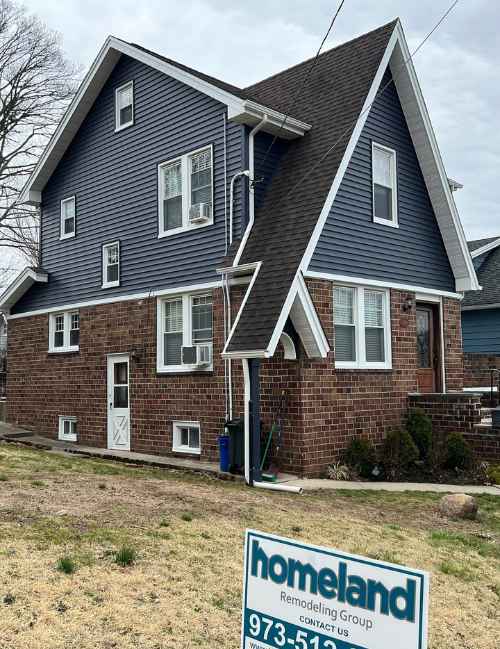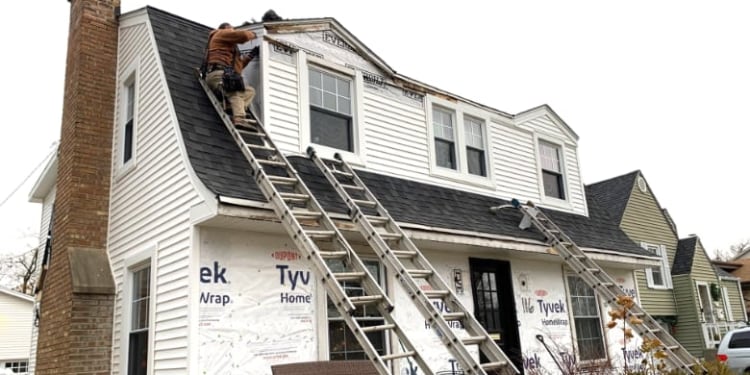Trusted Morris Siding Contractor for Durable and Affordable Home Siding
Trusted Morris Siding Contractor for Durable and Affordable Home Siding
Blog Article
The Vital Overview to the Different Kinds of House Siding and Their One-of-a-kind Benefits
In the realm of home renovation, picking the right siding is a vital choice that influences both aesthetic allure and practical efficiency. With so lots of choices to think about, which home siding product absolutely stands out for your details job?
Wood Exterior Siding
Timber exterior siding, a prominent selection for property outsides, uses a classic visual that incorporates all-natural charm with architectural honesty. This siding material is available in various designs, including clapboard, shingles, and board-and-batten, allowing homeowners to tailor their appearance to match their design choices. Wood exterior siding is usually crafted from resilient types such as cedar, redwood, or want, which are recognized for their resilience and ability to endure ecological stressors.
Among the main benefits of wood exterior siding is its outstanding insulation residential properties, which can add to energy performance and lower home heating costs. In addition, wood house siding is eco-friendly, making it an eco friendly alternative when sourced sustainably. Regular maintenance, including painting or staining, can extend its life expectancy and boost its look, enabling property owners to maintain the natural beauty of the wood.
Nevertheless, possible drawbacks include sensitivity to bugs, rot, and climate damage, necessitating adequate therapy and upkeep - morris siding contractor. Despite these worries, when appropriately looked after, wood home siding can provide a sturdy and stunning solution that boosts the character of a home while supplying a warm, inviting atmosphere

Plastic Exterior Siding
Vinyl exterior siding has actually emerged as a leading choice for house owners seeking a low-maintenance outside alternative that integrates sturdiness and cost. This flexible material is crafted from polyvinyl chloride (PVC), making it resistant to different weather, including moisture and UV rays. As a result, vinyl house siding does not warp, rot, or fade, making certain long-lasting visual appeal.
Among the main benefits of vinyl home siding is its extensive variety of designs and colors, enabling homeowners to attain the wanted appearance for their building without the requirement for frequent repainting. Additionally, plastic exterior siding is simple to set up, which can dramatically lower labor expenses during building or restoration jobs.
Plastic exterior siding additionally contributes to energy efficiency. Several alternatives attribute insulation backing, which improves thermal efficiency, aiding to preserve comfortable indoor temperatures and possibly lowering energy bills. Its smooth surface area assists in simple cleaning, calling for just routine washing with a yard tube to get rid of dirt and particles.
Fiber Cement Home Siding
Fiber cement exterior siding has actually gained traction among builders and property owners alike as a result of its remarkable combination of durability and aesthetic flexibility. Composed of a mix of sand, concrete, and cellulose fibers, this siding alternative is crafted to hold up against extreme climate condition, consisting of high winds, hefty rain, and temperature variations, making it a lasting selection for household outsides.

Among the key advantages of fiber cement siding is its resistance to pests, such as termites, and its non-combustible nature, offering enhanced fire safety. morris siding contractor. Furthermore, it is offered in a large selection of colors, appearances, and designs, allowing house owners to achieve their wanted visual without sacrificing performance
One more advantage is its reduced upkeep requirements; fiber cement home siding commonly requires painting or discoloration every 5-10 years, which is much less this post frequent than various other materials. Its long life adds to a reduced total cost of ownership, as it reduces the need for regular fixings or substitutes.
Ultimately, fiber concrete house siding stands for an excellent investment for those looking for a resistant, appealing, and versatile exterior choice, combining both type and function to enhance the home's visual allure.
Steel Exterior Siding
The allure of steel siding exists in its robust durability and contemporary visual allure, making it a favored option for modern design. Available in products such as light weight aluminum and steel, steel house siding uses a variety of finishes and colors, permitting property owners to attain a tailored look that matches their layout vision.

Energy effectiveness is one more significant advantage, as several steel exterior siding products are made with insulation alternatives that help control indoor temperature levels. This can lead to minimized power prices gradually. Additionally, metal home siding is frequently recyclable, making it an eco pleasant selection for sustainability-minded house owners.
The installation process for steel house siding can be relatively uncomplicated, causing a quicker turnaround time for construction jobs. In general, metal home siding integrates functionality and design, making it a functional option for those seeking a visually enticing and enduring outside surface.
Brick and Rock Home Siding
Brick and rock home siding stands out as an ageless selection that improves the aesthetic appeal of any home. Known for their durability and reduced maintenance, these materials give an outstanding roi while elevating the residential or commercial property's curb allure. Offered in numerous shades, textures, and patterns, brick and stone can be tailored to fit varied building designs, from typical to contemporary.
One of the main advantages of brick and stone house siding is their power effectiveness. Both products have natural insulating residential or commercial properties that help regulate indoor temperature levels, possibly decreasing cooling and heating prices. In addition, they provide superior fire resistance compared to various other home siding choices, adding to enhanced safety and security.
One more advantage is their long life. Block and rock can last for decades, usually calling for minimal maintenance past periodic cleansing. Unlike wood siding, they are invulnerable to bugs and rot, ensuring a durable exterior that holds up against the components.
Verdict
In summary, the option of siding dramatically affects a home's visual allure, power efficiency, and upkeep requirements. Each kind of house siding-- whether wood, plastic, fiber concrete, steel, or brick and rock-- supplies one-of-a-kind advantages tailored to different house owner choices and ecological conditions.
One of the primary advantages of wood siding is its superb insulation residential properties, which can check add to energy efficiency and lower home heating prices. Furthermore, timber home siding is naturally degradable, making it an environmentally friendly alternative when sourced sustainably.One of the primary advantages of metal siding is its resistance to different ecological variables.Energy effectiveness is one more significant benefit, as many steel siding products are made with insulation alternatives that assist control indoor temperature levels. Each kind of home siding-- whether wood, plastic, fiber concrete, steel, or block and rock-- uses one-of-a-kind benefits customized to various property owner preferences and ecological conditions.
Report this page